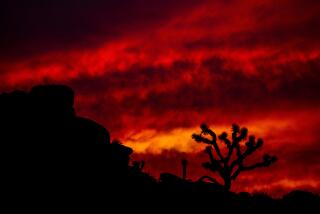Purple Reigns as Jacaranda Trees Blossom Across the Southland : The harbingers of hot weather show their lavender flowers for just six weeks. And there is that messy little problem about the sap.
Here’s a trivia question for the start of summer: What do Nairobi, Buenos Aires and Sherman Oaks have in common?
If you answered “main streets lined with jacaranda trees,” then put a purple flower in your cap.
As for the rest of you, it’s time to learn to appreciate that exotic tree hanging overhead, the bad and the beautiful of the plant kingdom.
City fathers in subtropical climes worldwide have seen fit to plant row upon row of blue-flowering jacaranda trees along their principal boulevards for the parading pleasure of emperors, dictators and generals.
Here, our buds have more democratic roots. So as a cool spring begins to wane and a blast-furnace summer to wax, jacarandas are tossing their blossoms like mad across Southern California neighborhoods.
Fecund harbingers of hot weather that flower for just six weeks, they are as messy as they are beautiful--pouring out a dazzling drizzle of purple petals that blanket anything that doesn’t move.
Are you prepared? Here’s a guide to Southern California’s annual Blue Period:
Where do jacarandas come from?
Authorities at the Los Angeles County Arboretum in Arcadia believe that travelers from southern Brazil brought the first jacaranda seeds here in the mid-1800s. Exactly when, no one’s sure. Arboretum consultant David O. Lofgren explained this in the technical jargon of his profession: “People bring in things and they don’t tell anybody.”
Are their flowers always purple?
Strangely enough, jacarandas are not supposed to be purple. Ideally, according to Lofgren, they should be deep blue. In fact, international flower cognoscenti scoff at the light lavender hues common in our area. Some of the best blues are reportedly found along the broad avenues of Buenos Aires in Argentina. Of course, flower breeders can’t leave well enough alone--so it’s occasionally possible to see white and even orange-flowering jacarandas.
What’s with the mist of sap that spews off jacaranda flowers and slimes my car?
Sorry to be the bearer of bad news, but that sticky stuff isn’t nectar or sap. It’s aphid waste. According to Lofgren, jacarandas are a favorite luncheon spot for millions of hungry aphids. They have to suck a lot of useless carbohydrates out of the flower nectar to get enough protein to keep their little brains sparking, and excrete whatever they don’t need through a “tiny spigot in their gut,” Lofgren said. Some PR agent for the Aphid Protective League long ago named this stuff “honeydew.” Ants adore honeydew, and protect aphids from such predators as ladybugs and parasitic wasps by stroking their backs like affectionate bodyguards.
Where are the best places to see jacarandas around here?
In “Exceptional Trees of Los Angeles,” author Donald Hodel commends a 50-foot jacaranda at 1870 Los Robles Ave. in San Marino.
In the San Fernando Valley, visit Stansbury Street or Dixie Canyon Avenue near Valley Vista Boulevard in Sherman Oaks, or Index Street in Granada Hills. Downtown, a handsome row of jacks frames the County Hall of Administration. In Beverly Hills, famous for its jacaranda-lined avenues, Whittier Street is a standout.
Is that really aphid poop on my Range Rover?
Yup.






